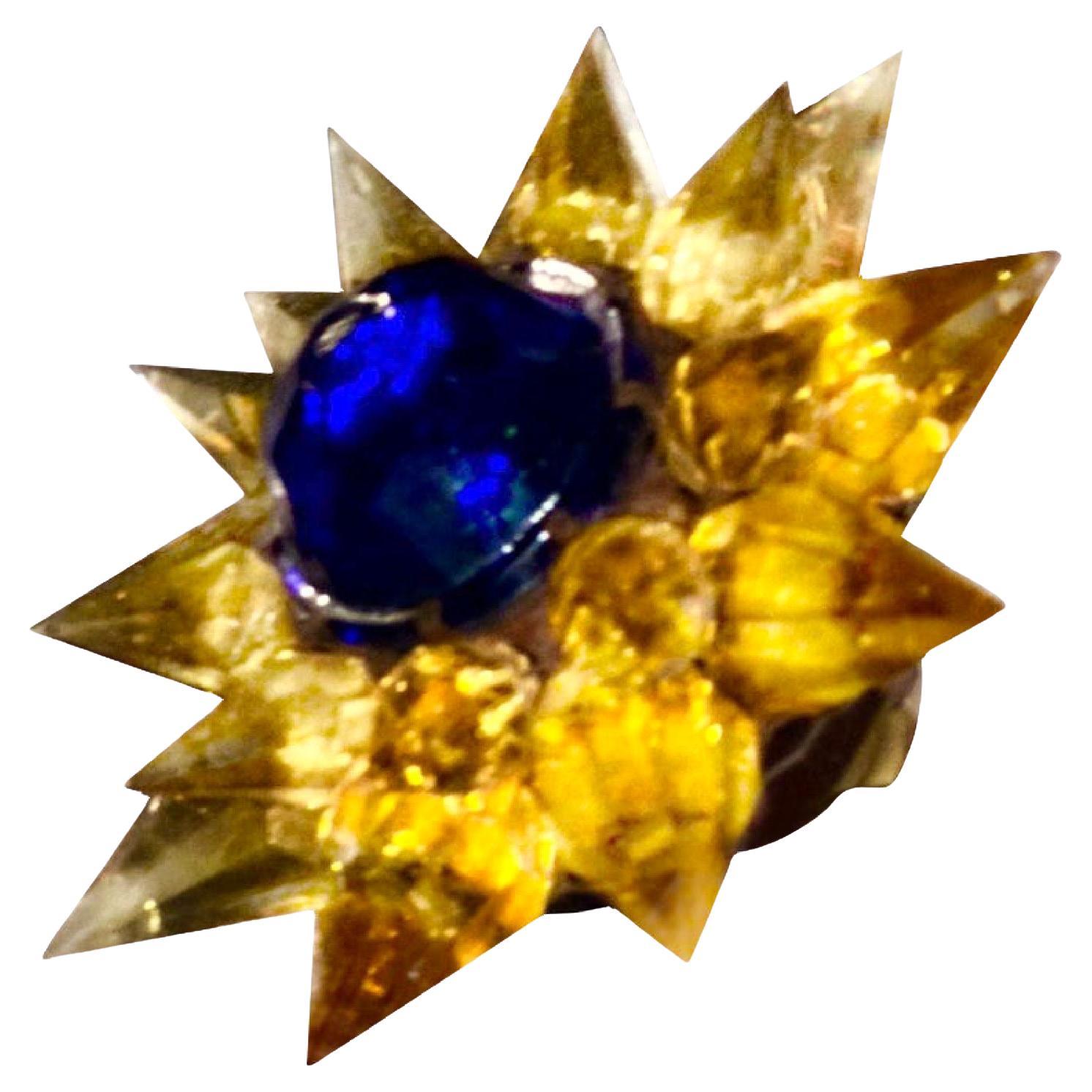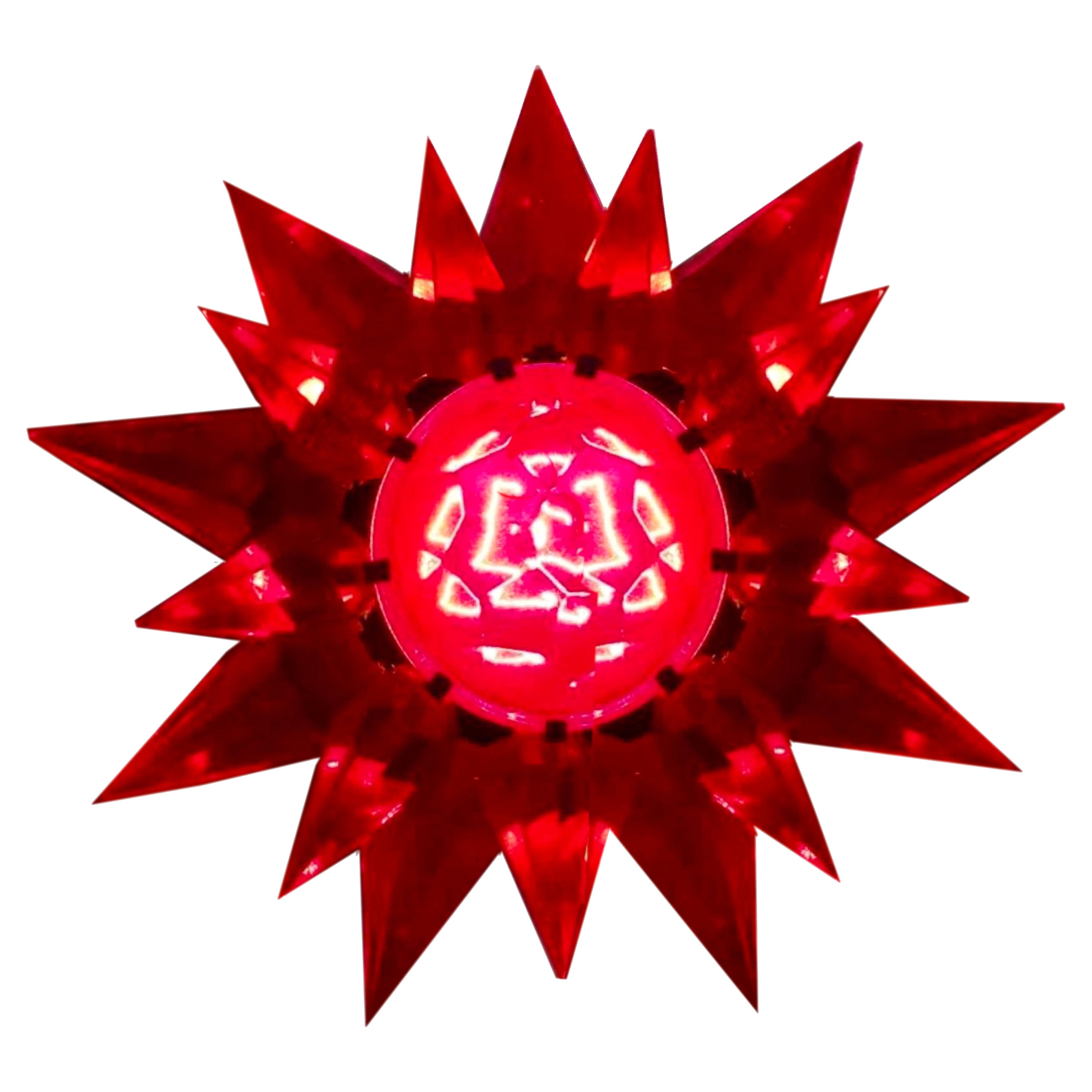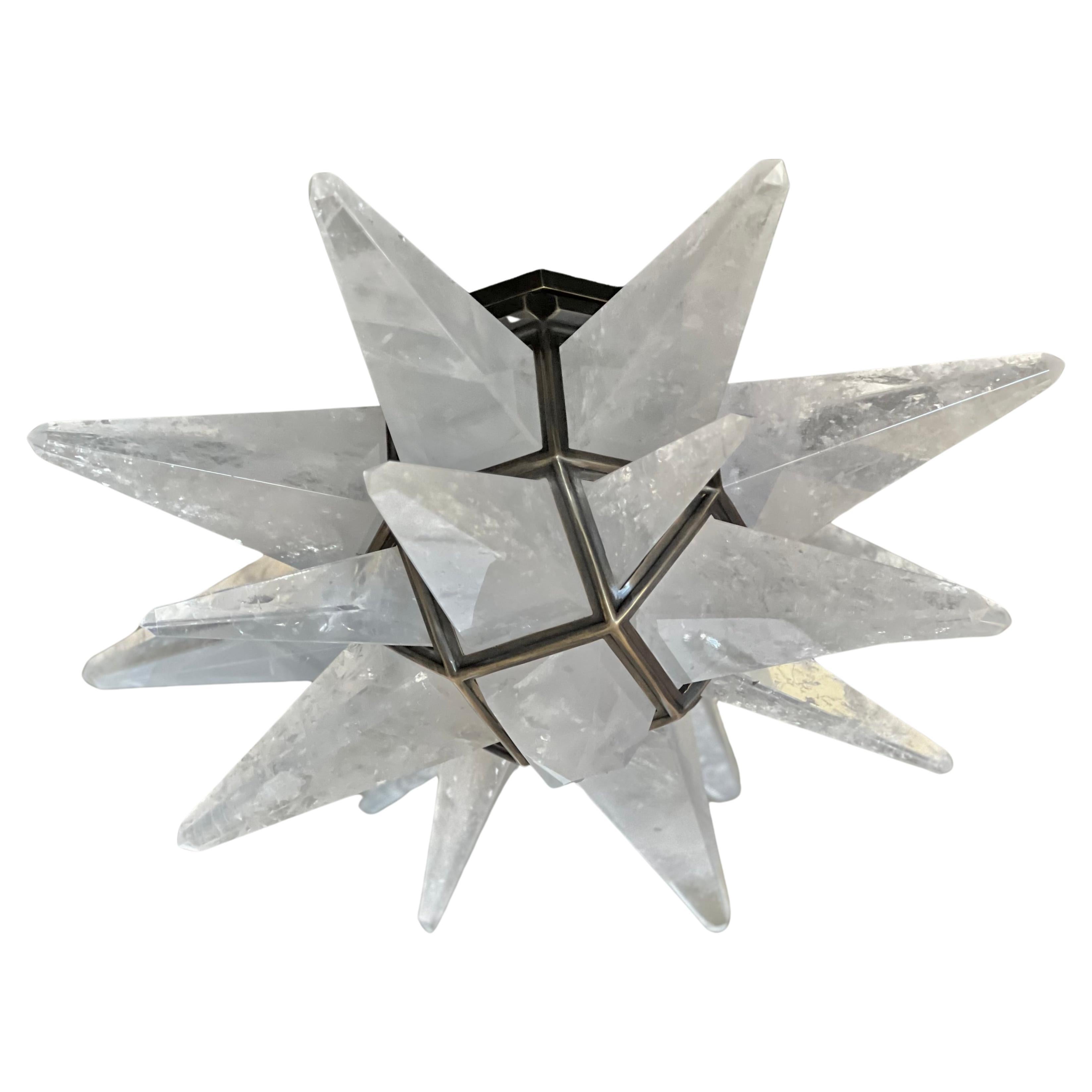Items Similar to Matchless Wonder Star #910 Double Row Green & Red Crystal C-9 Holiday Bulb, 1936
Video Loading
Want more images or videos?
Request additional images or videos from the seller
1 of 16
Matchless Wonder Star #910 Double Row Green & Red Crystal C-9 Holiday Bulb, 1936
About the Item
Matchless Wonder Star #910 Double Row Green & Red Crystal C-9 Holiday Bulb, 1936. Extremely rare early crystal production in green points with red center.
On May 2, 1935 Paul C. Dittman of Chicago filed an application for a patent for what he called simply "Decorative Lighting Device". In the patent he described it as "an ornamental device embodying a multiplicity of of prismatic light diffusing bodies with a light source..."
He related that while he was aware that others had patented lighted stars, his offering was different in that the light would enter the rays of the star radially, effectively refracting the light within the ray and producing a "pleasing effect."
His description of the refracted light produced by the stars was a bit of an understatement, as anyone who has seen them illuminated can attest: a lighted Matchless Wonder Star is stunningly beautiful. His patent was granted on December 8, 1936.
Paul Dittman, a German immigrant who passed through the gates of Ellis Island in New York City, worked for a time for George Westinghouse, where he got an education in the manufacturing of electric light bulbs. In 1912, Paul and his partners started the Matchless Electric Company, which was later incorporated (in 1918) "to manufacture, buy, sell and deal in electric supplies, light bulbs and radio tubes..." By 1930, the direction of the Company had changed a bit, and it was re-named The Century Lamp and Tube Company to reflect the fact that it was by this time the largest single licensee for the manufacture of RCA radio tubes. In addition to the tubes, the Company produced a large variety of small light bulbs, mainly miniature lamps that were used as indicators in telephone switch boards and various control panels, and automobile lamps as well. These lamps, an example of which is pictured below, are round, miniature based style with outside painted colors. These was even a Matchless brand set of Christmas lights available, which was a typical series string of eight cone shaped lamps.
In 1929, Mr. Dittman was the principle stockholder of a company incorporated as the D-G Electric Company, whose business was "to deal in all kinds and descriptions of electrical devices..." By 1931, the Company was renamed The Matchless Electric Company, and in 1934 the Century Lamp and Tube Company was dissolved.
The Matchless Electric Company of Chicago, Illinois made and sold these glass-prismed Christmas lights starting in about 1935, and continuing through the late 40s.The production of the Stars was a seasonal business for The Matchless Company, but Jim Dittman, inventor Paul's son, reports that the Stars were "my father's pride and joy." They were available in several sizes and many color combinations, and the glass points were made and hand cut in Czechoslovakia from authentic Austrian crystal. The lights were assembled and boxed in the United States. The earliest of these lights had a small paper label on one of the glass prisms, with "Made in Czechoslovakia" printed on it. The sticker was a bit confusing, as it referred only to the glass points and not the entire Star. During most of the year, the Company produced their regular stock of sewing machine, auto, radio pilot, aviation and instrument miniature lamps.
After World War II, the Company started selling their larger Stars made in Lucite instead of glass, as Communist occupation had cut off supplies of the needed Czechoslovakian crystal.
This page from a late 1930s hardware supply catalog features double Stars with various lamp sizes and color combinations. Also note the replacement lamps-something collectors would kill to get their hands on today, as the lamps with the bakelite backs have not been made for many years. Matchless Stars were some of the first Christmas lights offered with the ability to easily change the light bulb. NOMA had earlier offered their Dresden figural lights with changeable lamps, but the system was flawed and the socket parts froze together, making lamp exchange impossible.
Collectors who have researched these lights say that the Matchless Company did practically no advertising of this product, and references to the Stars can only be found in catalogs of the time. The 1939 and 1940 editions of Montgomery Wards Christmas catalogs feature them, and several hardware trade catalogs show the Stars. Matchless sold their Stars through the Marshall Fields stores as well. A major downside to these beautiful lights was their price-usually between 18 and 20 cents for a single row series 100 Star. While seemingly inexpensive in today's dollars, keep in mind that America was dealing with the effects of The Great Depression, and money was tight. An average Christmas tree of the time would feature between 40 and 48 miniature base series wired lights, and to fill the tree with Matchless Stars would have cost about $7.60. A typical boxed set of eight standard Christmas lights with the electrical cord sold for 65 cents in 1937, and a dozen eggs went for 12 cents. Spending almost $8.00 on Christmas lights was beyond the reach of many, so the Matchless Company wisely offered their Stars for sale singly as well as in sets of eight or ten.
The company offered their Stars in many different color combinations, with both clear and frosted crystals. The points were offered in red, green, aqua, steel blue, amethyst, pink, amber and clear. The center jewels were produced in red, green, amber and blue. Due to the Communist occupation of Czechoslovakia after World War II, the Matchless company found it difficult to obtain the proper quality glass crystals needed for the manufacture of their Stars. A redesign became necessary, and the larger Stars were then made in Lucite, and molded in one piece instead of individual points.
The piece available here is the largest and most rare of the Matchless Star production, #910 from series 900 (3.5” diameter). #910 featured a c-9 bulb, intermediate base. This is an authentic crystal version produced between 1936-1939. It comes with its original box. Original bulb. Working condition. Rare color combination. Ruby red central cut stone with gorgeous emerald green points. Double row.
- Dimensions:Height: 4 in (10.16 cm)Width: 3.5 in (8.89 cm)Depth: 3.5 in (8.89 cm)
- Materials and Techniques:
- Period:
- Date of Manufacture:1930s
- Condition:Wear consistent with age and use. Minor losses. Wear consistent with age and use. Minor losses. Minor fading. See photos. Good antique condition. Light surface wear possible. Bulb appears to be working at this time but it is original (1930’s) and so we do not guarantee it. Happy to refer you to a.
- Seller Location:Brooklyn, NY
- Reference Number:1stDibs: LU4190338854492
About the Seller
5.0
Platinum Seller
These expertly vetted sellers are 1stDibs' most experienced sellers and are rated highest by our customers.
Established in 2017
1stDibs seller since 2018
591 sales on 1stDibs
Typical response time: 1 hour
- ShippingRetrieving quote...Ships From: Brooklyn, NY
- Return PolicyA return for this item may be initiated within 1 day of delivery.
More From This SellerView All
- Matchless Wonder Star #910 Double Row Green Crystal Holiday C-9 Bulb, USA, 1936Located in Brooklyn, NYOn May 2, 1935 Paul C. Dittman of Chicago filed an application for a patent for what he called simply "Decorative Lighting Device". In the patent he described it as "an ornamental de...Category
Vintage 1930s Flush Mount
MaterialsCrystal
- Matchless Wonder Star #910 Double Row Amber & Blue Crystal C-9 Holiday Bulb 1936Located in Brooklyn, NYMatchless Wonder Star #910 Double Row Amber & Blue Crystal C-9 Holiday Bulb, 1936. Extremely rare early crystal production in the rarely seen Amber points with blue sapphire center. ...Category
Vintage 1930s American Art Deco Chandeliers and Pendants
MaterialsCrystal
- Matchless Wonder Star #910 Double-Row Red Crystal Holiday C-9 Bulb, USA, 1930sLocated in Brooklyn, NYMatchless Wonder Star #910 Double-Row Red Crystal Holiday C-9 Bulb, USA, 1930s. Extremely rare early crystal production with original box. On May 2, 1935 Paul C. Dittman of Chicago filed an application for a patent for what he called simply "Decorative Lighting Device". In the patent he described it as "an ornamental device embodying a multiplicity of of prismatic light diffusing bodies with a light source..." He related that while he was aware that others had patented lighted stars, his offering was different in that the light would enter the rays of the star radially, effectively refracting the light within the ray and producing a "pleasing effect." His description of the refracted light produced by the stars was a bit of an understatement, as anyone who has seen them illuminated can attest: a lighted Matchless Wonder Star is stunningly beautiful. His patent was granted on December 8, 1936. Paul Dittman, a German immigrant who passed through the gates of Ellis Island in New York City, worked for a time for George Westinghouse, where he got an education in the manufacturing of electric light bulbs. In 1912, Paul and his partners started the Matchless Electric Company, which was later incorporated (in 1918) "to manufacture, buy, sell and deal in electric supplies, light bulbs and radio tubes..." By 1930, the direction of the Company had changed a bit, and it was re-named The Century Lamp and Tube Company to reflect the fact that it was by this time the largest single licensee for the manufacture of RCA radio tubes. In addition to the tubes, the Company produced a large variety of small light bulbs, mainly miniature lamps that were used as indicators in telephone switch boards and various control panels, and automobile lamps as well. These lamps, an example of which is pictured below, are round, miniature based style with outside painted colors. These was even a Matchless brand set of Christmas lights available, which was a typical series string of eight cone shaped lamps. In 1929, Mr. Dittman was the principle stockholder of a company incorporated as the D-G Electric Company, whose business was "to deal in all kinds and descriptions of electrical devices..." By 1931, the Company was renamed The Matchless Electric Company, and in 1934 the Century Lamp and Tube Company was dissolved. The Matchless Electric Company of Chicago, Illinois made and sold these glass-prismed Christmas lights starting in about 1935, and continuing through the late 40s.The production of the Stars was a seasonal business for The Matchless Company, but Jim Dittman, inventor Paul's son, reports that the Stars were "my father's pride and joy." They were available in several sizes and many color combinations, and the glass points were made and hand cut in Czechoslovakia...Category
Early 20th Century American Art Deco Chandeliers and Pendants
MaterialsCrystal
- Vintage Camer Venini Murano Crystal Prism Flush Mount, 1970sLocated in Brooklyn, NYVintage Camer Venini Murano crystal prism flush mount, 1970s.Category
Mid-20th Century Italian Flush Mount
MaterialsCrystal, Brass
- Postmodern Frederick Ramond Riva Black Red Neon Flush Ceiling Light FixtureBy Fredrick RamondLocated in Brooklyn, NYGorgeous signed semi-flush mounted ceiling fixture by Frederick Ramond, 1980s, made in France. Gorgeous black and neon red/ vermillion acrylic. bulb is contained above the sandwiched...Category
Late 20th Century French Post-Modern Flush Mount
MaterialsSteel
- Red Triteti Flush Fixture, Ceiling or Wall, Vico Magistretti, Artemide, 1967By Vico Magistretti, Artemide, Ignazia Favata, Claudio DiniLocated in Brooklyn, NYRed Triteti flush fixture, Ceiling or Wall, Vico Magistretti for Artemide, 1967. Triteti was designed by Vico Magistretti and Claudio Dini for Artemide in 1967. This iconic design ca...Category
Vintage 1960s Italian Mid-Century Modern Flush Mount
MaterialsPlastic
You May Also Like
- Star15 Rock Crystal flushmount By PhoenixLocated in New York, NYRock Crystal Flush Mount with aged brass metal finish. two E12 sockets installed.160w total. Created by Phoenix. Custom size and metal finish upon request.Category
21st Century and Contemporary Flush Mount
MaterialsRock Crystal
- Midcentury Swedish Green Opaline Glass Brass Large Bulb-Shaped Pendant, 1960sLocated in Frankfurt am Main, DEA midcentury Bauhaus opaline glass and brass pendant, Germany, 1960s. Large bulb-shaped green opaline glass globe brass mounted, with a single brass and porcelain light socket for a ...Category
Mid-20th Century Scandinavian Mid-Century Modern Chandeliers and Pendants
MaterialsBrass
- STAR30 Rock Crystal Flush Mount by PhoenixLocated in New York, NYA fine carved star form rock crystal flush mount with matte nickel finished frame, created by Phoenix Gallery, New York City. Two sockets installed.Category
21st Century and Contemporary Flush Mount
MaterialsRock Crystal
- STAR25 Rock Crystal Flush Mount by PhoenixLocated in New York, NYA fine carved star form rock crystal flush mount with polished brass finished frame, created by Phoenix Gallery, New York City. For more Rock Crystal lightings and accessories from Phoenix gallery, please search "Phoenix Gallery " at Seller directory...Category
21st Century and Contemporary Flush Mount
MaterialsQuartz, Rock Crystal
- STAR19 Rock Crystal Flush mount by PhoenixLocated in New York, NYA fine carved star form rock crystal flush mount with matte nickel finished frame, created by Phoenix Gallery, New York City.Category
21st Century and Contemporary Flush Mount
MaterialsRock Crystal
- Star20 Rock Crystal Flush Mount by PhoenixLocated in New York, NYStar form rock crystal flush mount with polish brass frame. Each fixture installed two sockets. Crated by Phoenix gallery.Category
21st Century and Contemporary Flush Mount
MaterialsRock Crystal





